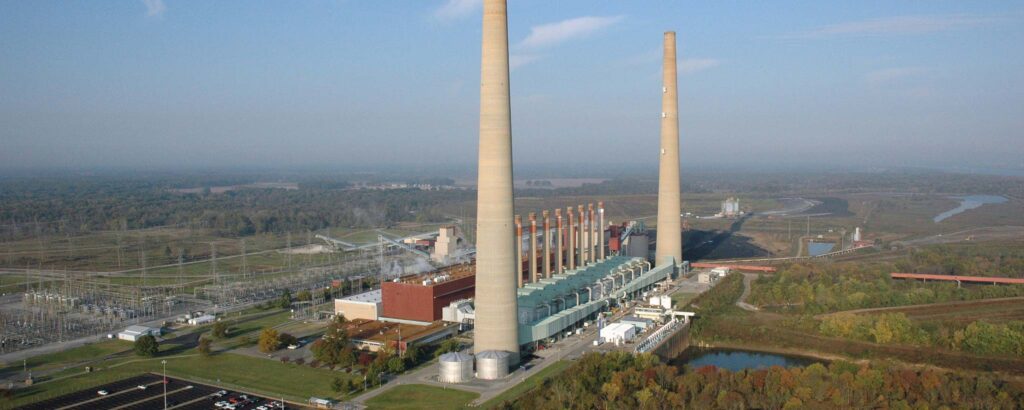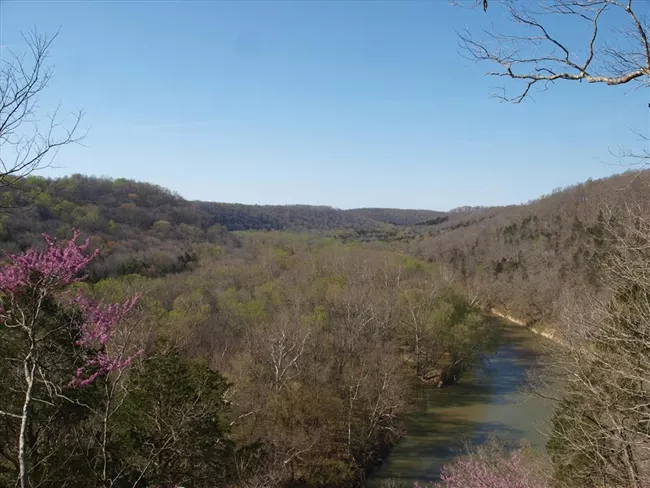5:50
News Story
Kentucky urged to curb air pollution that makes Mammoth Cave one of the haziest national parks
Mammoth Cave National Park is famous for what’s below the ground, featuring the world’s longest explored cave system with hundreds of miles of passages and a unique ecosystem of fish, insects, worms and crustaceans. But it’s what’s happening in the air above the cave system that has Kentucky environmentalists concerned.?
Mammoth Cave is one of the country’s haziest national parks, says a national group dedicated to conserving the parks. Environmental groups say a Kentucky plan being drafted for controlling the air pollution that causes haze falls short — criticisms state officials largely refute.

Haze is tiny, airborne particulate matter that can obscure outdoor visibility. It can be created from natural sources such as wildfires but largely comes from man-made sources, such as emissions from motor vehicles and power plants. This pollution can impact people’s health by aggravating asthma, reducing lung function and leading to heart problems. It can also negatively impact wildlife.
“We’re seeing more of these haze pollutants depositing into the soil and the water and impacting wildlife, because they eat a lot of things that are in the soil and in the water,” said Natalie Levine, the senior manager for clean air and climate programs at the National Parks Conservation Association (NPCA), the group that analyzed haze pollution in national parks.?
According to the NPCA, the large majority of that haze drifting into national parks is man-made. And at Mammoth Cave, more than 70% of pollution contributing to haze is coming from electricity generation — specifically coal-fired power plants.?
Smokestack emissions from coal-fired power plants contain toxic gasses sulfur dioxide and nitrogen dioxide, which can react with water and other atmospheric gasses to become acid rain that acidifies water and soil and harms the wildlife that rely on them. Excess nitrogen and sulfur from these gasses can be deposited into the soil and water through acid rain or by settling onto surfaces through the air, potentially killing and inhibiting the growth of trees and other plants.?

“We are concerned about our national parks. We’re concerned about their biodiversity. We’re concerned about hazy skies and giving people the best outdoor experience possible. But we’re really talking about the health of the communities as well,” said Julia Finch, the director of the Sierra Club’s Kentucky chapter.
A spokesperson for Kentucky’s environmental protection cabinet, however, says its efforts to reduce haze “are significantly reducing emissions”? and that air quality around the national park is better than national standards.?
John Mura, a spokesperson for the Kentucky Energy and Environment Cabinet that houses the Division for Air Quality, in a statement said the state is committed to working with federal agencies “and other interested parties to ensure the cleanest air quality possible for our citizens by understanding and addressing the emission sources that are contributing to visibility issues at Mammoth Cave National Park.”?
Slow improvements in haze
Haze protections for national parks date back to the establishment of the Clean Air Act in the 1960s and the additions and amendments added to it over the decades,?
In 1999, the U.S. Environmental Protection Agency (EPA), empowered through the Clean Air Act, issued new regulations requiring states to develop regional plans to reduce haze in national parks and control the pollution sources contributing to it. Such regional plans, for example, could require coal-fired power plants to install smokestack scrubbers or controls to filter out sulfur dioxide and nitrogen dioxide emissions. The long-term goal of the plans is to return national parks to their original natural visibility by 2064.?

But there have been a number of delays in getting states to submit these plans, Kentucky included. The EPA required the first version of these plans to be submitted by the end of 2007; Kentucky did, but 37 states did not. Progress reports on how states are meeting goals set in their haze plans are due every five years, and new versions of the regional haze plans are due every 10 years.?
The EPA set another deadline for states to submit their second version of regional haze plans in July 2021, a deadline that Kentucky and 14 other states did not meet. Kentucky is now trying to submit a new draft haze plan for the EPA to consider by a new deadline of Sept. 29 under the potential threat the EPA could step in and create its own haze plan for Kentucky.?
State officials say Kentucky’s first regional plan has decreased the state’s sulfur dioxide emissions by 310,047 tons since 2008, and that air quality at the park is better than national standards.?
Data from the National Park Service (NPS) does show visibility and the impacts of acid rain and ozone at the park have improved in a little over a decade since the state’s first haze plan was submitted, though acid rain and ozone are still impacting wildlife and human health.?
Median visibility at the park only reached a “fair” classification as of 2021 after having “poor” visibility since 2009, according to NPS data. The amount of sulfur and nitrogen deposited into the park’s soil and water every year through acid rain and the air has decreased, though sulfur levels have decreased much more significantly than nitrogen levels.?
The levels of ozone, a reactive gas largely created from emissions from power plants and cars that can harm human health, have also decreased since 2009. Ozone impacts to vegetation in the park are rated at a “good” level but remain as only “fair” for human health, according to the NPS.?
Environmentalists say more should be done
Even with that progress, environmental groups including the Kentucky Chapter of the Sierra Club and the Kentucky Resources Council, say the updated haze plan Kentucky is considering doesn’t do nearly enough to reduce air pollution impacting the park through haze and acid rain.??
These environmental groups say only two coal-fired power plants — the Tennessee Valley Authority’s Shawnee Fossil Plant in McCracken County and the Big Rivers Electric Corporation’s D.B. Wilson Generating Station — were analyzed by the state as potential sources of haze pollution in the draft plan when over a dozen more pollution sources including other power plants and industry are also contributing to the haze.?
Among the two power plants analyzed, these groups say, the state decided to not require any additional emissions controls to reduce nitrogen dioxide and sulfur dioxide emissions from the plants. The groups say state officials also only accounted for controlling sulfur dioxide emissions and not nitrogen dioxide emissions, which also can create haze.?
“In the excluded list were five coal plants and nine other industrial facilities, including those with aluminum and metal smelter operations, oil and gas operations, and lime and cement operations,” said Audrey Ernstberger, a lobbyist with the Kentucky Resources Council at a public hearing on the draft haze plan last month.

Ernstberger said the result, according to KRC’s analysis, is that more than 82,000 tons of haze pollution will still be released under the draft plan.?
In Kentucky’s draft plan, state officials write that because the electric utility Big Rivers Electric Corp. had installed a device in November 2022 to control sulfur dioxide at its Wilson coal-fired power plant, a deeper analysis into potential emissions controls wasn’t needed.?
Officials also write that the emission levels of nitrogen dioxide coming from the Wilson and Shawnee plants didn’t exceed “screening thresholds” in the state’s modeling, so officials “did not perform any reasonable progress analyses” for nitrogen dioxide emissions.?
For the Shawnee Fossil Plant, Mura said the state worked with the Tennessee Valley Authority to modify its state air permit to limit sulfur dioxide from the plant to 8,208 tons per year starting in 2028. State officials chose that limit following a deeper “four-factor” analysis conducted into potential emission controls for the coal-fired plant.?
When asked by the Lantern why the state chose only the Wilson and Shawnee plants to analyze for haze pollution, Mura said the state used modeling to determine the plants were “significantly impacting Mammoth Cave National Park and that limiting SO2 emissions at these facilities would have the greatest impact in improving visibility in the region.”?
If Kentucky meets the September deadline for submitting a haze plan, the EPA could approve the plan as is, ask the state to make revisions or step in and make its own plan. A federal judge last month signed a consent decree directing the EPA to speed up action on haze plans submitted by 32 other states.?
Hilary Lambert, a former Lexington resident who led a New York-based water protection nonprofit, said at the July public hearing she owns a cabin in Green County less than 50 miles east of Mammoth Cave National Park. She echoed what she wrote in a Louisville Courier-Journal column saying the state needs to do more to curb pollution and ensure compliance with state and federal regulations.?
“It's the state's own, the commonwealth's only big national park, and it's a jewel for people to visit,” Lambert said at the hearing. “Please get up to date and bring a number of businesses into compliance with the law to clean up the air for everybody.”

YOU MAKE OUR WORK POSSIBLE.
Our stories may be republished online or in print under Creative Commons license CC BY-NC-ND 4.0. We ask that you edit only for style or to shorten, provide proper attribution and link to our website. AP and Getty images may not be republished. Please see our republishing guidelines for use of any other photos and graphics.
Liam Niemeyer
Liam covers government and policy in Kentucky and its impacts throughout the Commonwealth for the Kentucky Lantern. He most recently spent four years reporting award-winning stories for WKMS Public Radio in Murray.
Kentucky Lantern is part of States Newsroom, the nation’s largest state-focused nonprofit news organization.





